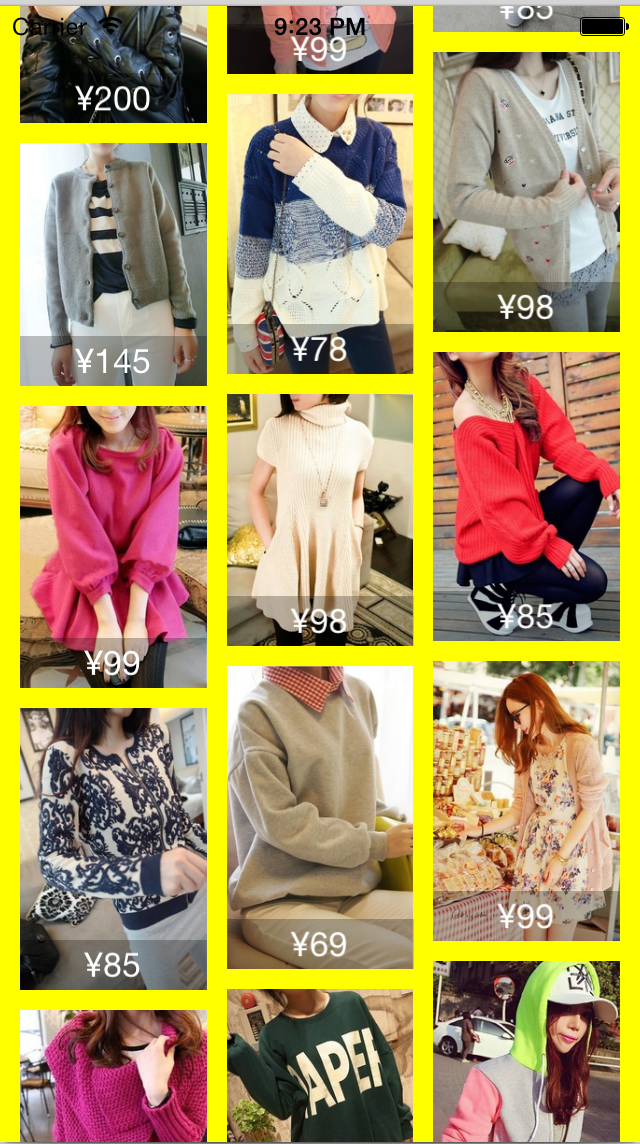一个瀑布流的实现有三种方式:
- 继承自UIScrollView,仿写UITableView的dataSource和delegate,创造一个缓存池用来实现循环利用cell
- 写多个UITableview(UITableView的cell宽度是与UITableView宽度一样的,那么每行可以摆设多个宽度相等的UITableView,从而实现瀑布流),不过这种方法是最差的,因为不能有效的做到循环利用cell
- 可以自定义UICollectionViewCell的布局,从而实现瀑布流,UICollectionView自带cell的循环利用功能
这里是使用UIScorllView实现的,就是第一种方案实现的,这种实现方式,自由度比之第三种方案更高。有时间我会写篇基于UICollectionView实现瀑布流的博客。
在此篇之前,最好是对UITableView里面dataSource和delegate有些深入的了解,如果有需要,可以参考这篇博客:http://www.cnblogs.com/ziyi--caolu/p/4769703.html
这里面提到了一些UITableView内部实现细节(当然是个人的猜想),然后仿照UITableView的delegate和dataSource写出了一个比较简单的例子,瀑布流可以算是前面那个例子的深入版。
从图中,可以得到基本的需求,也就是说,瀑布流每张图片的宽度是确定的,而高度是变化的(还有一种是高度是固定的,而宽度是变化的,实现原理一样)。
流布局结构,这说明要可以滚动。每张图片上,既要可以显示图片,又要可以显示文字,这仅仅是我写的这个medo的需求,在实际编程中,很有可能里面会装有各种控件。这种情况下,第一想法是UITableView和UITableViewCell,因为除了尺寸的问题外,UITableView的UITableViewCell是满足上述要求的,也就是一个cell里面可以装有各种控件,同时还可以循环利用cell。
那么,是否可以根据UITableView和UITableViewCell的设计,从而实现瀑布流呢?那么对应的,应该有ZYWaterFlowView和ZYWaterFlowViewCell吧?
首先,每张图片和文字会放在一个view里面,可以称呼它为waterFlowViewCell,如此先创建一个ZYWaterFlowViewCell类,里面有一个UIImageView和一个UILabel,这样cell部分好像可以满足基本需求了,至于要如何显示这个cell,应该是它父控件,也就是ZYWaterFlowView的事情。(先这样设计,后面有需要再修改)
再就是ZYWaterFlowView了,它要可以滚动,那么应当继承自UIScrollView,接下来就是获取cell如何排列的数据了。
这一部分,可以参考UITableView的设计,UITableVIew是通过让viewController遵守它的UITableViewDataSource和UITableViewDelegate协议,从而不断的向viewController要各种必须的数据,进而展示出cell的,而UITableView的重新排列是reLoaddata方法。(开篇提到的参考博客里详细说了这个过程,这里不再重述)
那么,ZYWaterFlowView完全可以参照这种设计,从而拿到自己必须的数据,处理响应的事件。
- ZYWaterFlowView肯定是要知道会有多少数目的ZYWaterFlowViewCell的,就如遵守UITableViewDataSource总要实现这两个方法:
- (NSInteger)numberOfSectionsInTableView:(UITableView *)tableView
- (NSInteger)tableView:(UITableView *)tableView numberOfRowsInSection:(NSInteger)section
UITableView通过在.m文件里调用[self.dataSource numberOfSectionsInTableView:self]从而得知,有多少组?
通过调用[self.dataSource tableView:self numberOfRowsInSection:section]每组有多少行?(开篇提到的参考博客里详细说了这个过程,这里不再重述)
那么,我们可以对应的写出下面这个方法,创建一个ZYWaterFlowViewDataSource协议,在协议里面声明下面的这个必须要实现的方法,从而让ZYWaterFlowView可以通过同样的方式而得知cell的具体数目:
//返回cell的数目
- (NSInteger)numberOfCellsInWaterFlowView:(ZYWaterFlowView *)waterFlowView;
2. 我们总得拿到cell吧?不然怎么展示它?怎么实现循环利用功能?就如UITableViewDataSource里面的这个方法:
- (UITableViewCell *)tableView:(UITableView *)tableView cellForRowAtIndexPath:(NSIndexPath *)indexPath
UITableView是通过这样调用[self.dataSource tableView:self cellForRowAtIndexPath:indexPath],从而得到相对应位置的cell的,那么我的ZYWaterFlowView完全可以参照这种方式写出一个方法,从而得到我对应index的cell,如此,应该有下面这个方法:
//返回index位置对应的cell
- (ZYWaterFlowViewCell *)waterFlowView:(ZYWaterFlowView *)waterFlowView cellAtIndex:(NSUInteger)index;
3. 上面两个方法,在ZYWaterFlowViewDataSource协议是要用@required关键字修饰的,意为遵守协议就必须实现的方法,负责就会产生错误。那么总该有一些不那么重要的数据,给我们来自定义一些东西吧?这里我是声明了一个返回自定义列数(默认为三列)的方法:
@optional
//一共多少列
- (NSInteger)numberOfColumnsInWaterFlowView:(ZYWaterFlowView *)waterFlowView;
下面就是仿照UITableViewDelegate的一些设计了,用法和UITableViewDataSource是相同的,这里不再复述,只是需要注意的是,我们应该尽可能好的设计UIWaterFlowViewDelegate,从而让用这套框架的同事觉得很好用,不需要再修改。(我并未去设计很多方法,主要是没时间,事实上,我觉得完全可以将UITableViewDelegate里面的很多方法在这里写上)。
@optional
//返回index的cell的高度
- (CGFloat)waterFlowView:(ZYWaterFlowView *)waterFlowView heightAtIndex:(NSUInteger)index;
//各种间距
- (CGFloat)waterFlowView:(ZYWaterFlowView *)waterFlowView marginForType:(ZYWaterFlowViewMarginType)type;
//返回被选中的(孩子~~)cell
- (ZYWaterFlowViewCell *)waterFlowView:(ZYWaterFlowView *)waterFlowView didSelectedAtIndex:(NSUInteger)index;
仅有上面说的这些还不够,参考UITableView,他还有reloadData方法,可以猜想,这个方法是用来重新布局cell的(也就是从新计算cell尺寸的),如果需要创建缓存池,从而实现cell的循环利用,那么UITableView提供了这个方法:
- (id)dequeueReusableCellWithIdentifier:(NSString *)identifier;
那么从仿照的角度上来说,ZYWaterFlowView也得实现这两个方法,从而处理相应的事情。到此,ZYWaterFlowView的.h文件,有了下面的设计:
#import <UIKit/UIKit.h>
typedef enum {
ZYWaterFlowViewMarginTypeTop,
ZYWaterFlowViewMarginTypeLeft,
ZYWaterFlowViewMarginTypeBottom,
ZYWaterFlowViewMarginTypeRight,
ZYWaterFlowViewMarginTypeRow,
ZYWaterFlowViewMarginTypeColumn
}ZYWaterFlowViewMarginType;
@class ZYWaterFlowView, ZYWaterFlowViewCell;
@protocol ZYWaterFlowViewDataSource <NSObject>
@required
//返回cell的数目
- (NSInteger)numberOfCellsInWaterFlowView:(ZYWaterFlowView *)waterFlowView;
//返回index位置对应的cell
- (ZYWaterFlowViewCell *)waterFlowView:(ZYWaterFlowView *)waterFlowView cellAtIndex:(NSUInteger)index;
@optional
//一共多少列
- (NSInteger)numberOfColumnsInWaterFlowView:(ZYWaterFlowView *)waterFlowView;
@end
@protocol ZYWaterFlowViewDelegate <UIScrollViewDelegate>
@optional
//返回index的cell的高度
- (CGFloat)waterFlowView:(ZYWaterFlowView *)waterFlowView heightAtIndex:(NSUInteger)index;
//各种间距
- (CGFloat)waterFlowView:(ZYWaterFlowView *)waterFlowView marginForType:(ZYWaterFlowViewMarginType)type;
//返回被选中的(孩子~~)cell
- (ZYWaterFlowViewCell *)waterFlowView:(ZYWaterFlowView *)waterFlowView didSelectedAtIndex:(NSUInteger)index;
@end
@interface ZYWaterFlowView : UIScrollView
@property (nonatomic, weak) id<ZYWaterFlowViewDataSource> dataSource;
@property (nonatomic, weak) id<ZYWaterFlowViewDelegate> delegate;
//刷新数据
- (void)reloadData;
//根据identifier去缓存池找到对应的cell
- (id)dequeueReusableCellWithIdentifier:(NSString *)identifier;
@end
接下来就是.m文件里面的实现了。上面提到,我们应该在reloadData方法里面布局cell,那么瀑布流的cell应该如何布局呢?是按照从左到右、从上到下的顺序依次放入cell么?肯定不是的,前面提到,瀑布流的cell只是宽度相同,而高度不相同,如果是按照从左到右、从上到下的顺序依次放入cell的排列,最后非常有可能出现某一列高度很高,某一列高度很低等的情况。
基于这样的思考,我们该这样,如果要排列当前的一个cell,那么应该知道各列的最高高度,将当前的这个cell放入最高高度最小的那一列,然后更新那一列的最高高度,并保存。这里我用c语言中的数组保存,因为oc数组必须保存对象,操作也耗时些。
想想,在reloadData方法里面,我们必须拿到总的cell数目,还好,dataSource协议里面已经提供了方法,我们只需要调用那个方法,然后拿到相应的数据即可,然后是根据代理里面提供的各种间距、宽度、高度,根据“将当前的这个cell放入最高高度最小的那一列”布局好cell(也就是设置好所有的cell的frame),并更新最大高度,设置好UIScrollView的contentSize属性(也就是UIScrollView的滚动范围,应该是最高列+底部间距)。还有一个问题,就是该如何保存这些cell的frame呢?很简单,放到数组(NSMutableArray *cellFrames)里面即可,要用到的时候,根据相应的index(索引)取出来即可。
既然每个cell的frame已经计算好了,那么该拿到相应的cell(view),展示在屏幕上了。scrollView在滚动的时候,除了会调用它delegate里面的一些方法之外,还会调用
- (void)layoutSubviews
如此,我们在这里面拿到cell,并拿到对应下标的cellFrames里面的元素设置cell的frame。初看,并没有什么问题,但实际上,这样做的话,并未实现循环利用,不仅仅如此,还会重复创建cell的bug。
因此,在这个方法里面,应该先拿到对应下标的cell的frame,再判断这个cell是否正展示在屏幕上?可以与scrollView的contentOffSet属性判断,只要,cell的最大的y大于contentOffset.y,最小的y小于contentOffset.y + self(这里应该是屏幕)的高度,那么该cell就是要展示在屏幕上的。这里会有一个字典(NSMutableDictionary *displayingCells),会装有这一次滚动前展示在屏幕上得cell,如果只是小范围滚动的话,那么displayingCells里可能还有一些cell展示在屏幕上,而我们应该并那些没有展示在当前屏幕上得cell从scrollView(也就是ZYWaterFlowView,也就是self)里面移除掉,又因为displayingCells存放的是当前正展示在屏幕上的cell,那么相应的,应当将之从displayingCells里面移除,放到缓存池里面去(这里的缓存池,设计为NSMutableSet *reusableCells)。下面是主要代码:
//当scrollView滚动,除了会调用它的代理方法之外,还会时时调用这个方法
//所以,在这个方法里面拿到当前显示在屏幕的cell,设置尺寸~~
- (void)layoutSubviews
{
[super layoutSubviews];
int numberOfCells = (int)[self.dataSource numberOfCellsInWaterFlowView:self];
for (int i = 0; i < numberOfCells; i++) {
//先在scrollView上存在的cell里看当前cell是否存在scrollView(self)上
ZYWaterFlowViewCell *cell = self.displayingCells[@(i)];
CGRect cellF = [self.cellFrames[i] CGRectValue];
if ([self isInScreen:cellF]) { //判断当前cell是否有在屏幕展示(注意,这里与在scrollView(self)上展示不同)
if (cell == nil) { //需要在屏幕展示,所以cell不存在的时候需要创建
cell = [self.dataSource waterFlowView:self cellAtIndex:i];
cell.frame = cellF;
[self addSubview:cell];
self.displayingCells[@(i)] = cell; //添加到了scrollView上,所以将它加入字典中
}
}else
{
if (cell) { //没在屏幕上,所以不需要cell,把它放入缓存池
[cell removeFromSuperview];
[self.displayingCells removeObjectForKey:@(i)]; //这个字典是用来记录正展示在屏幕上得数组的,没有在
// 屏幕上了,应当移除相应的cell
//放入缓存池
[self.reusableCells addObject:cell]; //既然要循环利用,那么创建了,就不应该在
//ZYWaterFlowView生命周期还未结束之前被销毁
//那么将之放入缓存池
}
}
}
}
接下来,应担是缓存池的实现主要代码,其实有了上面的铺垫,是很简单的,主要是根据identifier找到对应identifier的cell,如果没找到,就返回nil,下面试代码:
//需要根据标示符去缓存池找到对应的cell
- (id)dequeueReusableCellWithIdentifier:(NSString *)identifier
{
__block ZYWaterFlowViewCell *cell;
[self.reusableCells enumerateObjectsUsingBlock:^(ZYWaterFlowViewCell *obj, BOOL *stop) {
if ([obj.identifier isEqualToString:identifier]) {
cell = obj;
*stop = YES;
}
}];
if (cell) { //被用了,就从缓存池中移除
[self.reusableCells removeObject:cell];
}
return cell;
}
相对应的,上面所说的ZYWaterFlowViewCell的设计不合理,事实上,参考UITableViewCell的设计,其实ZYWaterFlowViewCell只需要有一个identifier属性就好,如何你要用的cell有很复杂的控件,那么只需要继承ZYWaterFlowViewCell,给identifier标示,就可以了,用法和UITableViewCell一致,所以,我最终的ZYWaterFlowViewCell是这样设计的:
#import <UIKit/UIKit.h>
@interface ZYWaterFlowViewCell : UIView
@property (nonatomic, copy) NSString *identifier;
- (instancetype)initWithIdentifier:(NSString *)identifier;
@end
#import "ZYWaterFlowViewCell.h"
@implementation ZYWaterFlowViewCell
- (instancetype)initWithIdentifier:(NSString *)identifier
{
if (self = [super init]) {
self.identifier = identifier;
}
return self;
}
@end
写到了这,最主要的功能就剩下点击时间没处理了,比如说,我点击了某个cell,想要对它进行一定的处理,也就是ZYWaterFlowViewDelegate里面的这个方法碰触时:
//返回被选中的(孩子~~)cell
- (ZYWaterFlowViewCell *)waterFlowView:(ZYWaterFlowView *)waterFlowView didSelectedAtIndex:(NSUInteger)index;
如何实现这样一个功能呢?其实就是在touches系类方法里面,判断此次点击事件在哪个位置,然后哪个cell包含这个位置,调用上面的方法,返回响应索引即可,代码:
- (void)touchesEnded:(NSSet *)touches withEvent:(UIEvent *)event
{
//如果没有实现此代理,直接返回
if (![self.delegate respondsToSelector:@selector(waterFlowView:didSelectedAtIndex:)]) return;
UITouch *touch = [touches anyObject];
CGPoint currentPoint = [touch locationInView:self];
__block NSNumber *index = nil;
//判断触摸点在哪个cell上,没必要遍历所有的cell,只需要遍历,当前展示在scrollView的cell(屏幕更好)
[self.displayingCells enumerateKeysAndObjectsUsingBlock:^(id key, ZYWaterFlowViewCell *obj, BOOL *stop) {
if (CGRectContainsPoint(obj.frame, currentPoint)) {
index = key;
*stop = YES;
}
}];
if (index) {
[self.delegate waterFlowView:self didSelectedAtIndex:index.unsignedIntegerValue];
}
}
下面是真个.m文件的代码,一些次要的东西,就没有详细说明了,我觉得,这玩意主要是思路,因为相对来说,技术是学不完的,最值钱的是思想。
#import "ZYWaterFlowView.h"
#import "ZYWaterFlowViewCell.h"
#define ZYWaterFlowViewDefaultNumberOfColumns 3
#define ZYWaterFlowViewDefaultCellH 65
#define ZYWaterFlowViewDefaultMargin 10
@interface ZYWaterFlowView ()
//存放所有cell的frame
@property (nonatomic, strong)NSMutableArray *cellFrames;
//存放在scrollView的cell,之所以用字典,因为可以用key来存取,方便添加和移除
//当,发现当前key值得cell在字典里面(也就是还在scrollView上,也许正在屏幕上,也许没有在屏幕上,但在scrollView上),直接从字典中取出即可,如果字典中不存在
//则去缓存池里取,如果缓存池没有,那么创建cell
@property (nonatomic, strong)NSMutableDictionary *displayingCells;
//“缓存池”,存放离开屏幕的cell
@property (nonatomic, strong)NSMutableSet *reusableCells;
@end
@implementation ZYWaterFlowView
- (NSMutableArray *)cellFrames
{
if (_cellFrames == nil) {
_cellFrames = [NSMutableArray array];
}
return _cellFrames;
}
- (NSMutableDictionary *)displayingCells
{
if (_displayingCells == nil) {
_displayingCells = [NSMutableDictionary dictionary];
}
return _displayingCells;
}
- (NSMutableSet *)reusableCells
{
if (_reusableCells == nil) {
_reusableCells = [NSMutableSet set];
}
return _reusableCells;
}
- (CGFloat)cellWidth
{
int numberOfColumns = (int)[self numberOfColumns];
CGFloat marginOfColumn = [self marginForType:ZYWaterFlowViewMarginTypeColumn];
CGFloat marginOfRight = [self marginForType:ZYWaterFlowViewMarginTypeRight];
CGFloat marginOfLeft = [self marginForType:ZYWaterFlowViewMarginTypeLeft];
CGFloat cellW = (self.frame.size.width - (numberOfColumns - 1) * marginOfColumn - marginOfLeft - marginOfRight) / numberOfColumns;
return cellW;
}
//刷新数据
- (void)reloadData
{
[self.displayingCells.allValues makeObjectsPerformSelector:@selector(removeFromSuperview)];//先把当前展示在scrollView上得移除,再去清空其他容器
[self.displayingCells removeAllObjects];
[self.cellFrames removeAllObjects];
[self.reusableCells removeAllObjects];
int numberOfCells = (int)[self.dataSource numberOfCellsInWaterFlowView:self];
int numberOfColumns = (int)[self numberOfColumns];
CGFloat marginOfTop = [self marginForType:ZYWaterFlowViewMarginTypeTop];
CGFloat marginOfBottom = [self marginForType:ZYWaterFlowViewMarginTypeBottom];
CGFloat marginOfRow = [self marginForType:ZYWaterFlowViewMarginTypeRow];
CGFloat marginOfLeft = [self marginForType:ZYWaterFlowViewMarginTypeLeft];
CGFloat marginOfColumn = [self marginForType:ZYWaterFlowViewMarginTypeColumn];
//这里,使用一个c语言数组,来装载每一列的最大高度
//为什么不是oc数组?因为oc数组要装对象,还不能预先开好位置
CGFloat maxYOfColumns[numberOfColumns];
for (int i = 0; i < numberOfColumns; i++) {
maxYOfColumns[i] = 0.0;
}
CGFloat cellW = [self cellWidth];
for (int i = 0; i < numberOfCells; i++) {
//最小的y所在列
int minYAtCol = 0;
//所有列中最小的y
CGFloat minY = maxYOfColumns[minYAtCol];
for (int j = 1; j < numberOfColumns; j++) {
if (minY > maxYOfColumns[j]) {
minY = maxYOfColumns[j];
minYAtCol = j;
}
}
CGFloat cellH = [self cellHeightAtIndex:i];
CGFloat cellX = marginOfLeft + minYAtCol * (cellW + marginOfColumn);
CGFloat cellY = 0;
if (minY == 0.0) {
cellY = marginOfTop;
}else
{
cellY = minY + marginOfRow;
}
CGRect cellFrame = CGRectMake(cellX, cellY, cellW, cellH);
[self.cellFrames addObject:[NSValue valueWithCGRect:cellFrame]];
//更新这一行的y
maxYOfColumns[minYAtCol] = CGRectGetMaxY(cellFrame);
}
//设置scrollView的滚动范围
CGFloat maxY = maxYOfColumns[0];
for (int i = 1; i < numberOfColumns; i++) {
if (maxY < maxYOfColumns[i]) {
maxY = maxYOfColumns[i];
}
}
maxY += marginOfBottom;
self.contentSize = CGSizeMake(0, maxY);
}
//当scrollView滚动,除了会调用它的代理方法之外,还会时时调用这个方法
//所以,在这个方法里面拿到当前显示在屏幕的cell,设置尺寸~~
- (void)layoutSubviews
{
[super layoutSubviews];
int numberOfCells = (int)[self.dataSource numberOfCellsInWaterFlowView:self];
for (int i = 0; i < numberOfCells; i++) {
//先在scrollView上存在的cell里看当前cell是否存在scrollView(self)上
ZYWaterFlowViewCell *cell = self.displayingCells[@(i)];
CGRect cellF = [self.cellFrames[i] CGRectValue];
if ([self isInScreen:cellF]) { //判断当前cell是否有在屏幕展示(注意,这里与在scrollView(self)上展示不同)
if (cell == nil) { //需要在屏幕展示,所以cell不存在的时候需要创建
cell = [self.dataSource waterFlowView:self cellAtIndex:i];
cell.frame = cellF;
[self addSubview:cell];
self.displayingCells[@(i)] = cell; //添加到了scrollView上,所以将它加入字典中
}
}else
{
if (cell) { //没在屏幕上,所以不需要cell,把它放入缓存池
[cell removeFromSuperview];
[self.displayingCells removeObjectForKey:@(i)]; //这个字典是用来记录正展示在屏幕上得数组的,没有在
// 屏幕上了,应当移除相应的cell
//放入缓存池
[self.reusableCells addObject:cell]; //既然要循环利用,那么创建了,就不应该在
//ZYWaterFlowView生命周期还未结束之前被销毁
//那么将之放入缓存池
}
}
}
}
//需要根据标示符去缓存池找到对应的cell
- (id)dequeueReusableCellWithIdentifier:(NSString *)identifier
{
__block ZYWaterFlowViewCell *cell;
[self.reusableCells enumerateObjectsUsingBlock:^(ZYWaterFlowViewCell *obj, BOOL *stop) {
if ([obj.identifier isEqualToString:identifier]) {
cell = obj;
*stop = YES;
}
}];
if (cell) { //被用了,就从缓存池中移除
[self.reusableCells removeObject:cell];
}
return cell;
}
#pragma Private方法
//判断是否在屏幕上,只需要,最大的y大于contentOffset.y,最小的y小于contentOffset.y + self高度
- (BOOL)isInScreen:(CGRect)rect
{
return (CGRectGetMaxY(rect) > self.contentOffset.y) && (CGRectGetMinY(rect) < self.contentOffset.y + self.frame.size.height);
}
- (CGFloat)cellHeightAtIndex:(int)index
{
if ([self.delegate respondsToSelector:@selector(waterFlowView:heightAtIndex:)]) {
return [self.delegate waterFlowView:self heightAtIndex:index];
}
return ZYWaterFlowViewDefaultCellH;
}
- (int)numberOfColumns
{
if ([self.dataSource respondsToSelector:@selector(numberOfColumnsInWaterFlowView:)]) {
return (int)[self.dataSource numberOfColumnsInWaterFlowView:self];
}
return ZYWaterFlowViewDefaultNumberOfColumns;
}
- (CGFloat)marginForType:(ZYWaterFlowViewMarginType)type
{
if ([self.delegate respondsToSelector:@selector(waterFlowView:marginForType:)]) {
return [self.delegate waterFlowView:self marginForType:type];
}
return ZYWaterFlowViewDefaultMargin;
}
- (void)touchesEnded:(NSSet *)touches withEvent:(UIEvent *)event
{
//如果没有实现此代理,直接返回
if (![self.delegate respondsToSelector:@selector(waterFlowView:didSelectedAtIndex:)]) return;
UITouch *touch = [touches anyObject];
CGPoint currentPoint = [touch locationInView:self];
__block NSNumber *index = nil;
//判断触摸点在哪个cell上,没必要遍历所有的cell,只需要遍历,当前展示在scrollView的cell(屏幕更好)
[self.displayingCells enumerateKeysAndObjectsUsingBlock:^(id key, ZYWaterFlowViewCell *obj, BOOL *stop) {
if (CGRectContainsPoint(obj.frame, currentPoint)) {
index = key;
*stop = YES;
}
}];
if (index) {
[self.delegate waterFlowView:self didSelectedAtIndex:index.unsignedIntegerValue];
}
}
//当view将要移到superView时,刷新数据,避免手动刷新
- (void)willMoveToSuperview:(UIView *)newSuperview
{
[self reloadData];
}
@end
这是这个项目的github地址,medo已经集成上拉刷新、下拉刷新:https://github.com/wzpziyi1/waterFlowView-demo

